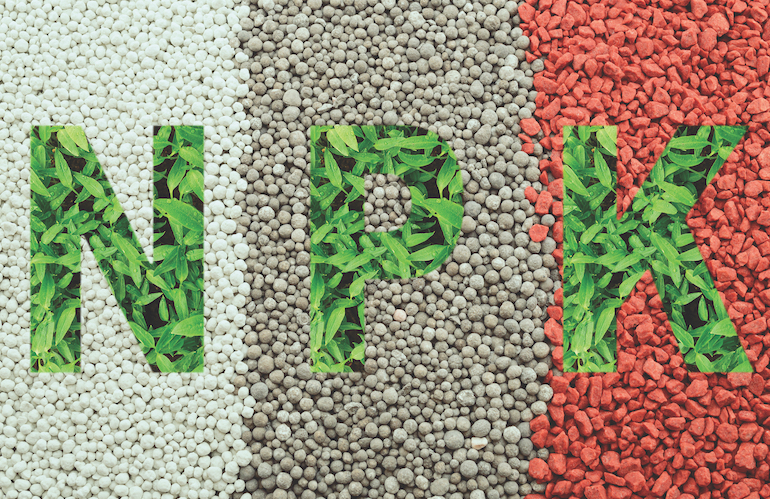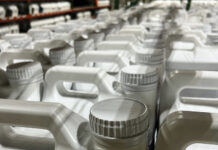Micronutrients, acids, biostimulants? Today’s labels go beyond NPK. Here’s a primer.
Historically, the NPK analysis told you everything you needed to know about a fertilizer: the percentages of nitrogen, phosphorus, and potassium. You would just test your soil, determine your turf’s fertility needs, and find a product with your desired three-number combination.
Today, fertilizer selection has become a more cryptic process with the growing emphasis on micronutrients and nutrient sources in general. But it doesn’t have to be overwhelming. In this article, we’ll discuss what fertilizer is, how to make buying decisions, and where soil conditioners, amendments, and biostimulants fit into the whole picture.

What Is Fertilizer?
At its simplest, fertilizer is food for plants. Like you and me, plants require certain macronutrients and micronutrients. Seventeen elements are essential for plants.
The first three are carbon (C), hydrogen (H), and oxygen (O)—plants source these through photosynthesis. Then there are the primary macronutrients: nitrogen (N), phosphorus (P), and potassium (K) which exist in the soil, but not always in sufficient amounts. That’s where the standard NPK fertilizer comes in to supplement.
The secondary macronutrients are essential in lower amounts than the primary ones, but higher than micronutrients. They are calcium (Ca), magnesium (Mg), and sulfur (S). Lastly, micronutrients are essential, but in the lowest amounts. They are boron (B), chlorine (Cl), copper (Cu), iron (Fe), manganese (Mn), molybdenum (Mo), nickel (Ni), and zinc (Zn).
Fertilizer ingredients, differing in efficacy, include mineral nutrients, amino acids, organics, poly-aspartic acid, humic and fulvic acids, and seaweed, among others.
Amino acids improve nitrogen fixation to optimize nitrogen delivery to the plant. They also increase the production of chlorophyll and plant energy. The plant can utilize the amino acids to make the metabolites it needs, taking some burden off.
Organics provide nutrients over time, feeding biology as they break it down and release nutrients. Compost can act as a soil conditioner by adding organic matter and feeding the biology in the soil.
Liquid vs. Granular
The most significant trend I expect to see over the next decade is the transition from granular to liquid fertilizer in lawn care. Historically, liquid fertilizer was the mainstay of turf applications, but the tech was somewhat limited. Granular fertilizer became more popular as it had better performance and allowed larger areas to be applied more efficiently. Yet these days, we have more tech available for liquid applications that improve performance and enable applicators to be more efficient on lawns that are 10,000 square feet in size or less. We are seeing more companies adopting liquid applications with great success.
The liquid category has two subcategories: foliar and soil drench. Foliar fertilizers are applied to plant foliage using a sprayer. Liquid fertilizers for turfgrass are foliar-applied products. Soil drench products are used on ornamental plants and trees, which can be very useful if your company treats more than just grass.
Within granular fertilizers, there are other subcategories. As many know, straight granular requires a spreader to apply and requires irrigation to water in the product. Temperature also affects application success. For these reasons, granular fertilizer is more fickle. Water-soluble granular fertilizers are dissolved and then foliar-applied or drenched. Foliar-applied fertilizers are then taken into the soil by irrigation and rain at a faster pace.
Granular fertilizers are sometimes blended with chemicals to control weeds, disease, or insects and allow application efficiencies. The vast majority of crabgrass control products are applied on fertilizer as well as grub control applications.
Decisions, Decisions
The debate between liquid and granular is controversial in our industry, but I am a proponent of adopting more liquid programs. Liquid fertilizer is more cost-effective and flexible while providing quicker green-up. Some excellent technology and products are available now to improve performance.
With tighter budgets, liquid fertilizer is an excellent way to save. Even investment in liquid application equipment is just that: an investment. It will pay off within a season.











![[VIDEO] Dickies®: Discover Workwear That’s Anything But Uniform](https://turfmagazine.com/wp-content/uploads/2023/06/1647663814-4b1a2a7742790a9b1e97a3b963477850192e1d6a9dfba9b07214a77bae25d6e3-d-218x150.jpg)






























![[VIDEO] Dickies®: Discover Workwear That’s Anything But Uniform](https://turfmagazine.com/wp-content/uploads/2023/06/1647663814-4b1a2a7742790a9b1e97a3b963477850192e1d6a9dfba9b07214a77bae25d6e3-d-324x160.jpg)
Do the liquid fertilizers stay in the soil, or do they get flushed out with irrigation or rain? If they do get flushed out, what sort of danger does the excess fertilizer pose to wetlands and ground water